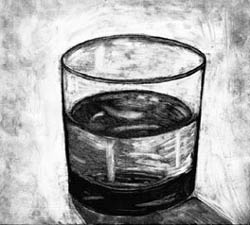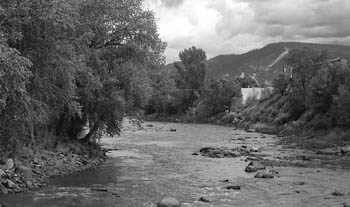Durango tangles with murky drinking water
by Will Sands/Photos by Jamie Morehart
 It doesn’t take a degree in hydrology to realize that there
is currently something wrong with the Durango water supply. Tongues
throughout town have picked up swampy flavors, a white film is
consistently showing up on dishes, clean laundry has been hard
to come by and watering restrictions are imminent. However, the
upside is that there is no hazard to health according to Durango
officials, who are working overtime to provide solutions to the
recent shock to local water quality.
It doesn’t take a degree in hydrology to realize that there
is currently something wrong with the Durango water supply. Tongues
throughout town have picked up swampy flavors, a white film is
consistently showing up on dishes, clean laundry has been hard
to come by and watering restrictions are imminent. However, the
upside is that there is no hazard to health according to Durango
officials, who are working overtime to provide solutions to the
recent shock to local water quality.
“It’s difficult
to categorize the current situation as a crisis, but it’s
certainly a different circumstance than anything we’ve dealt
with before,” says Durango Public Works Director Jack Rogers.
Rogers is referring to
the dark brown hue common to the Animas River lately combined
with the city’s present reliance on the river for drinking
water. Normally, the city taps the Florida River for the majority
of its drinking water. However, low flows and fluctuations on
the usual source have sent the city to the more reliable Animas.
Landscapes scarred by this summer’s wildfires and the resulting
flash floods have led to heavy silt and ash loads and ultimately
poor water quality on both rivers.
The cloudiness of water,
or turbidity, is measured in units called ntu’s. Normally,
turbidity in the Animas is 1.5 ntu, and the city is required to
treat to a level of less than .3 ntu. “What we saw on Saturday
was above 500 ntu,” says Rogers of the present near crisis.
 Quality
not quantity Quality
not quantity
The city is pumping water
from the Animas at Santa Rita Park up to the 7.5-million gallon
Terminal Reservoir above Hillcrest Golf Course. Once there, the
sediment is given an opportunity to settle out prior to treatment.
The sticking point comes with Durango’s average use of 5
million gallons of water per day, a reality that could require
watering restrictions during times in which the river is running
muddy.
“It’s a quality
issue, purely quality not quantity,” said Chris Wilbur,
Durango Water Commission member.
In late August, the Durango
City Council voted to give authority to impose emergency water
restrictions to City Manager Bob Ledger. Violators would receive
one verbal warning and subsequent infractions would result in
a fine, up to $300. Water Commission member Kent Ford has made
the suggestion that when needed, emergency restrictions be ordered
swiftly and for a duration of three days.
“It seems to me
that we should be quick to pull that trigger,” he said.
“You don’t want three or four days to pass when you’re
pumping bad water.”
 Dirty
but bacteria free Dirty
but bacteria free
Three or four days of
pumping silt-laced water would have consequences at the tap. And
though tap water as of late has tasted swampy and left residue
on dishes, Rogers assures that the water is currently safe to
drink. The laboratory at San Juan Basin Health Department concurs,
saying that tests for bacteria in Durango’s drinking water
have turned up negative.
“There are no health
concerns about the water right now,” says Rogers. “There
are concerns about the increasing hardness of the water.”
The swampy flavor was
the result of a brief and harmless algae bloom. “I didn’t
know if it was getting better, or I was getting used to it,”
said Fred Kroeger, Water Commission member.
The increasing hardness
of tap water has led to the film on dishes and difficulty in getting
clothes clean. The problem’s cause is the city’s shift
from the Florida to Animas. “We’re seeing mineralization,
primarily calcium, in the Animas that’s exacerbated in times
of drought,” says Rogers.
While water hardness seems
to be no big deal, the city also is keeping its eye on a potential
health risk. Water quality tests Aug. 5 turned up the presence
of organic carbon in Durango’s drinking water. On the one
hand, organic carbon leads to discoloring of the water. On the
other, it poses a health risk when combined with chlorine, a key
component of water treatment.
“When the water
is chlorinated, the carbon changes, and high levels of chlorinated
hydrocarbons have a health effect when they persist over a long
time,” said Rogers. The only hang-up is that Durango currently
has no equipment capable of treating organic carbon. “Organics
aren’t going to be easily removed,” says Rogers. “If
we have to treat the organics we would have to lease new equipment.”
Rogers says he expects
the organic carbon to continue to taper off, but that he “can’t
guarantee that the water will be back to an acceptable level.”
As a result, the city is prepared to lease equipment if need be.
(continued...)
|

